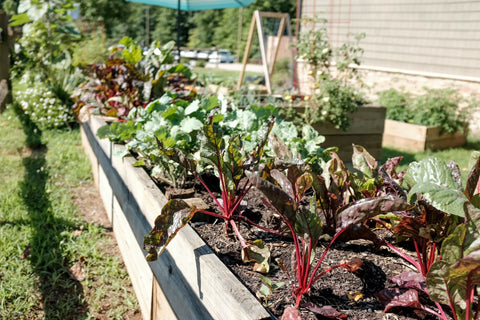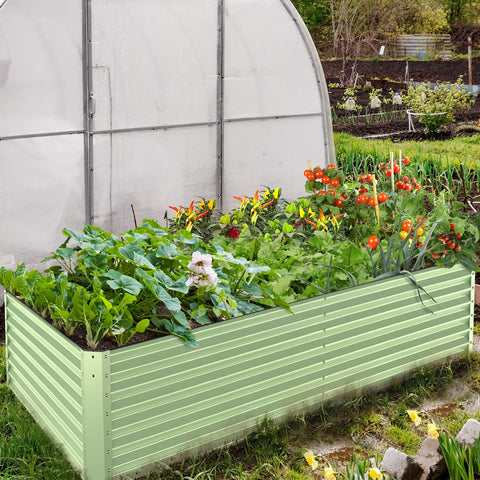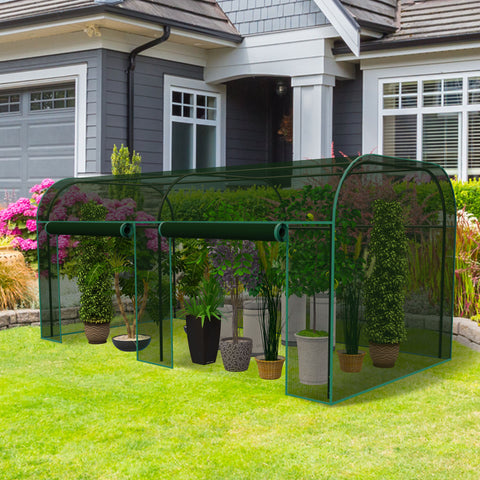Leafy greens are among the healthiest and most versatile vegetables you can grow in your garden. They're packed with essential nutrients, easy to cultivate, and perfect for salads, soups, and stir-fries. If you're looking to maximize your leafy green harvest, consider planting them in a raised garden bed. In this blog, we'll explore the tips and step-by-step process of growing leafy vegetables in a raised garden bed, helping you achieve a bountiful and healthy harvest.

Advantages of Growing Leafy Greens in Raised Garden Beds
Before we dive into the tips and process, let's understand why raised garden beds are an excellent choice for cultivating leafy vegetables:
- Better Drainage: Raised beds provide excellent drainage, preventing waterlogged soil, which can be detrimental to leafy greens.
- Soil Quality: You have more control over the soil quality in a raised bed. You can customize the mix to suit the specific needs of leafy greens.
- Reduced Weeding: Raised beds tend to have fewer weeds, reducing competition for nutrients and sunlight.
- Easier Maintenance: Raised beds are at a comfortable height, making it easier to plant, weed, and harvest without straining your back.
Growing Leafy Greens in a Raised Garden Bed: Step-by-Step
-
Select the Right Location:
- Choose a sunny spot for your raised bed, as leafy greens thrive in sunlight. Ideally, you should aim for at least 6 hours of direct sunlight daily.
-
Build or Prepare the Raised Bed:
- If you don't already have a raised bed, build one to your preferred size and height. The typical depth is around 12-18 inches.
- Ensure the bed has good drainage, either by adding gravel to the bottom or selecting a well-draining location.
-
Select the Soil Mix:
- Use a high-quality potting mix or create a custom blend of compost, garden soil, and vermiculite for ideal moisture retention and drainage.
- Leafy greens prefer slightly acidic soil, so you may need to adjust the pH level if necessary.
-
Planting Leafy Greens:
- Start by spacing your plants according to their specific requirements. Leaf lettuce, for example, can be spaced about 6 inches apart, while kale may need up to 18 inches.
- Dig small holes or furrows for the seeds or seedlings, ensuring they're at the appropriate depth.
- Water the bed thoroughly before planting, and water again after planting to help settle the soil.
-
Mulching and Watering:
- Apply a layer of organic mulch around the plants to retain moisture and prevent weeds.
- Water your leafy greens consistently, aiming for at least 1 inch of water per week. Adjust based on your local climate and weather conditions.
-
Fertilization:
- Fertilize your leafy greens with a balanced, all-purpose fertilizer. Be mindful not to over-fertilize, as excessive nutrients can lead to poor-quality greens.
-
Pest and Disease Management:
- Keep an eye out for common pests like caterpillars, slugs, and aphids. Consider natural pest control methods like neem oil or introducing beneficial insects.
- Monitor for signs of diseases, such as leaf spots or mildew, and address them promptly with appropriate treatments.
-
Harvesting:
- Harvest them when they reach the size you desire. Pick outer leaves to encourage continued growth.
- Use clean, sharp scissors or shears to prevent damage to the plants.

Tips for a Successful Leafy Greens Harvest
Here are some additional tips to help you achieve a successful leafy greens harvest in your raised garden bed:
- Succession Planting: To ensure a continuous supply of fresh greens, plant new seeds or seedlings every few weeks. This staggered approach prevents a single large harvest and helps you enjoy a steady supply.
- Shade Cloth: In hot summer months, use shade cloth to protect your leafy greens from scorching sun and bolting (premature flowering).
- Crop Rotation: Practice crop rotation in your raised bed to prevent soil depletion and reduce the risk of disease and pests.
- Thinning: Thin seedlings to the recommended spacing to allow for better airflow and prevent overcrowding.
- Companion Planting: Consider planting companion plants like garlic or onions to deter pests from your leafy greens.
- Cover in Cold Weather: If you garden in a colder climate, consider using row covers or cloths to protect your leafy greens from frost and extend your growing season.
Leafy Green Varieties for Raised Garden Beds
Now, let's explore these excellent leafy green varieties to consider for your raised garden beds:
- Lettuce (Various Varieties): From butterhead to romaine, lettuce is a classic choice for fresh salads.
- Spinach: Packed with nutrients, spinach is perfect for salads, sandwiches, and cooked dishes.
- Kale: A nutritional powerhouse, kale comes in various types, including curly and lacinato.
- Arugula: Known for its peppery flavor, arugula is a fantastic addition to salads.
- Swiss Chard: With colorful stems, Swiss chard is as ornamental as it is delicious.
- Collard Greens: Popular in Southern cuisine, collard greens are hearty and nutritious.
- Bok Choy: This Asian green is great for stir-fries and soups.
- Mustard Greens: Spicy and versatile, mustard greens add zing to dishes.
- Endive: With a slightly bitter flavor, endive is perfect for adding complexity to salads.
- Radicchio: Its vibrant red leaves and slightly bitter taste make radicchio a gourmet choice.
- Cilantro: This herb is a must-have for Mexican and Asian cuisine.
- Parsley: A versatile herb, parsley is excellent for garnishing and flavoring dishes.
- Sorrel: Known for its lemony taste, sorrel is a unique addition to salads and soups.
- Mizuna: An Asian green with a mild, peppery flavor, mizuna is great for salads and stir-fries.
- Dandelion Greens: Often considered a weed, dandelion greens are nutrient-rich and have a slightly bitter taste.

Conclusion
Growing leafy greens in a raised garden bed can be a rewarding and straightforward endeavor, whether you're a seasoned gardener or a beginner. By selecting the right location, preparing your raised bed, and following the planting and care tips outlined in this blog post, you'll be on your way to enjoying a bountiful harvest of fresh and nutritious leafy vegetables. So, roll up your sleeves, get your hands in the soil, and watch your garden bed flourish with an abundance of healthy greens.









